Physiological Abnormalities in Mrs R with Diabetes
VerifiedAdded on 2023/01/19
|5
|1176
|56
AI Summary
This document discusses the physiological abnormalities observed in Mrs R, a patient with diabetes. It explores the impact of diabetes on various body systems and the resulting complications. The document also provides insights into the causes and implications of these abnormalities.
Contribute Materials
Your contribution can guide someone’s learning journey. Share your
documents today.
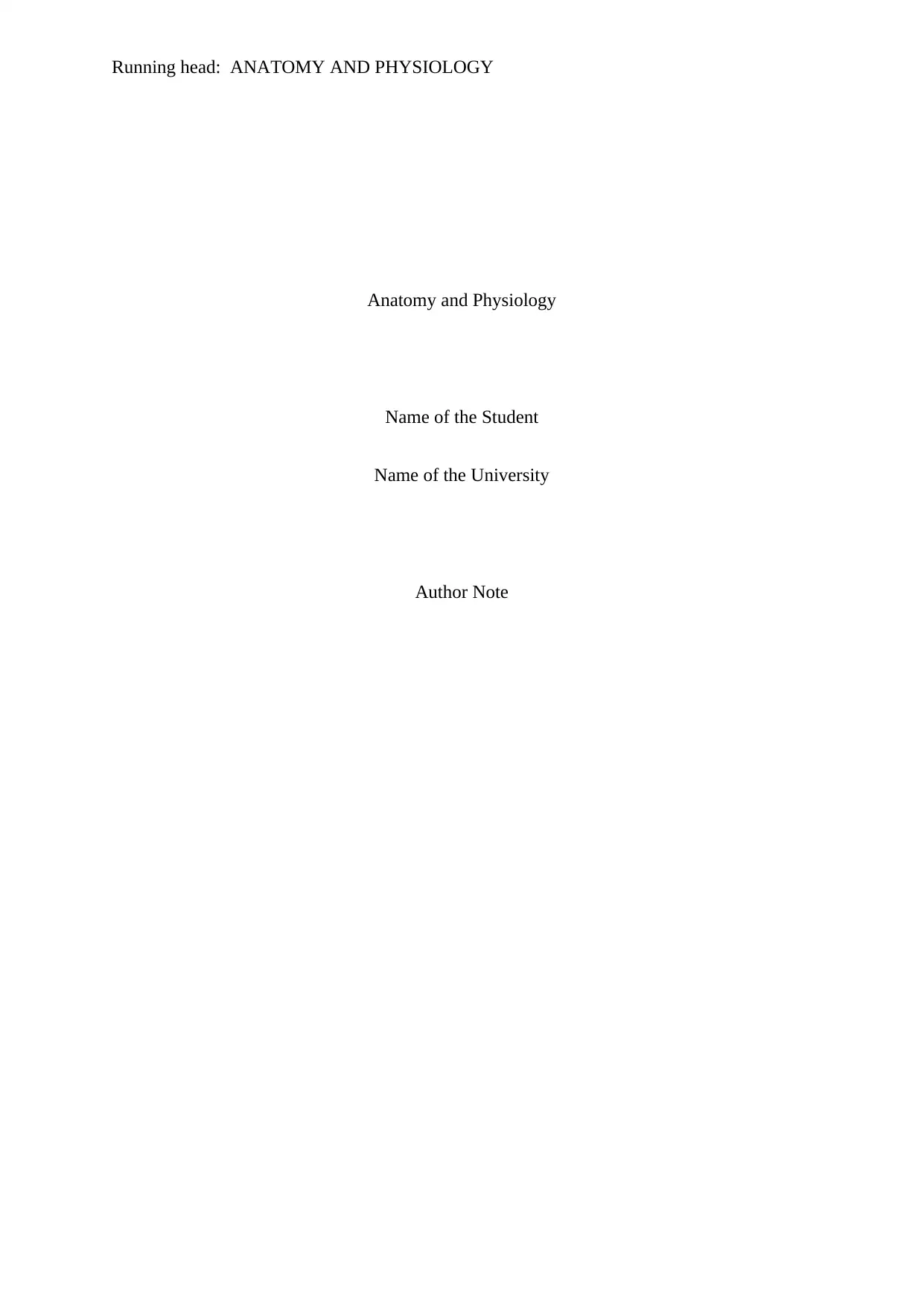
Running head: ANATOMY AND PHYSIOLOGY
Anatomy and Physiology
Name of the Student
Name of the University
Author Note
Anatomy and Physiology
Name of the Student
Name of the University
Author Note
Secure Best Marks with AI Grader
Need help grading? Try our AI Grader for instant feedback on your assignments.
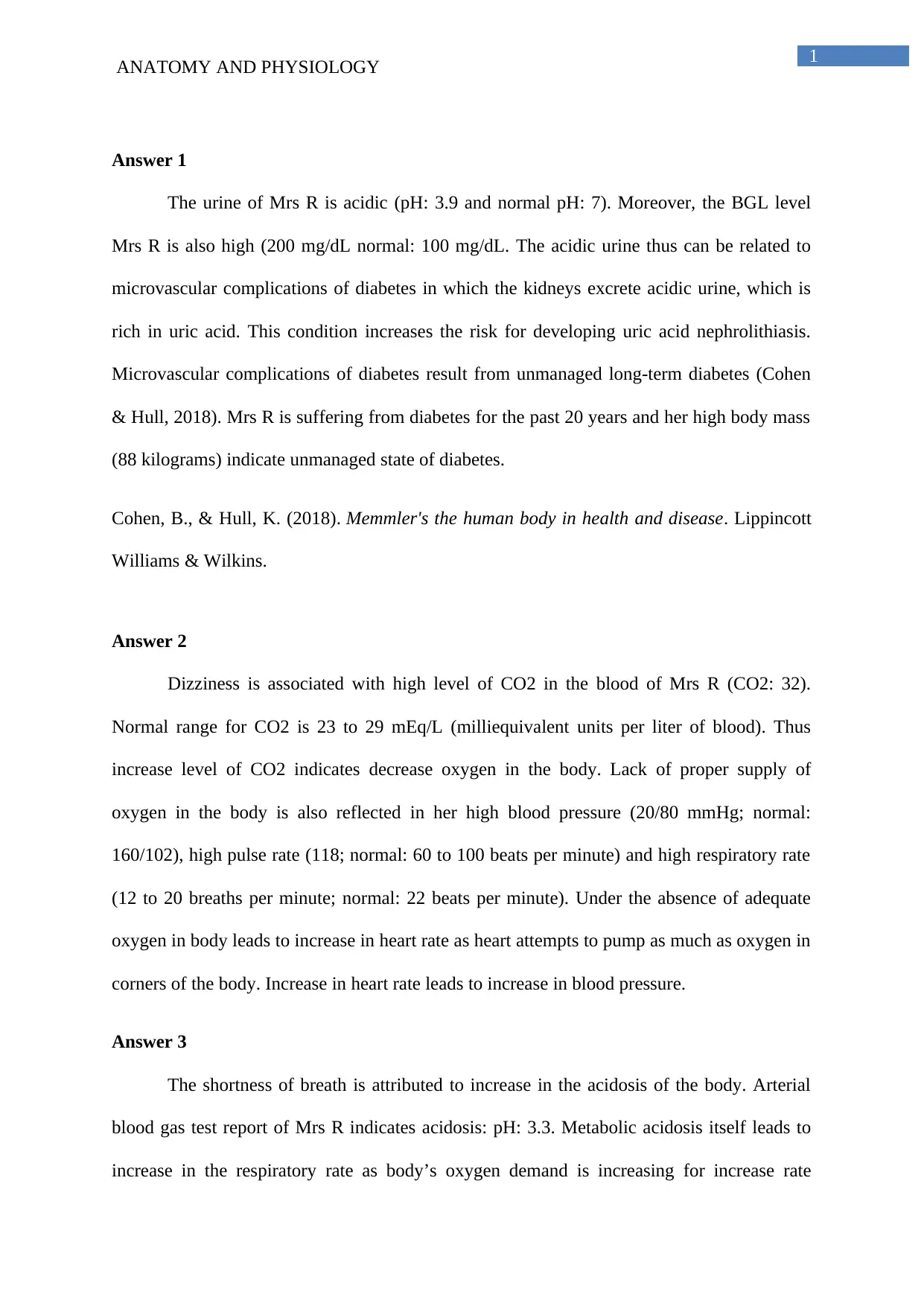
1
ANATOMY AND PHYSIOLOGY
Answer 1
The urine of Mrs R is acidic (pH: 3.9 and normal pH: 7). Moreover, the BGL level
Mrs R is also high (200 mg/dL normal: 100 mg/dL. The acidic urine thus can be related to
microvascular complications of diabetes in which the kidneys excrete acidic urine, which is
rich in uric acid. This condition increases the risk for developing uric acid nephrolithiasis.
Microvascular complications of diabetes result from unmanaged long-term diabetes (Cohen
& Hull, 2018). Mrs R is suffering from diabetes for the past 20 years and her high body mass
(88 kilograms) indicate unmanaged state of diabetes.
Cohen, B., & Hull, K. (2018). Memmler's the human body in health and disease. Lippincott
Williams & Wilkins.
Answer 2
Dizziness is associated with high level of CO2 in the blood of Mrs R (CO2: 32).
Normal range for CO2 is 23 to 29 mEq/L (milliequivalent units per liter of blood). Thus
increase level of CO2 indicates decrease oxygen in the body. Lack of proper supply of
oxygen in the body is also reflected in her high blood pressure (20/80 mmHg; normal:
160/102), high pulse rate (118; normal: 60 to 100 beats per minute) and high respiratory rate
(12 to 20 breaths per minute; normal: 22 beats per minute). Under the absence of adequate
oxygen in body leads to increase in heart rate as heart attempts to pump as much as oxygen in
corners of the body. Increase in heart rate leads to increase in blood pressure.
Answer 3
The shortness of breath is attributed to increase in the acidosis of the body. Arterial
blood gas test report of Mrs R indicates acidosis: pH: 3.3. Metabolic acidosis itself leads to
increase in the respiratory rate as body’s oxygen demand is increasing for increase rate
ANATOMY AND PHYSIOLOGY
Answer 1
The urine of Mrs R is acidic (pH: 3.9 and normal pH: 7). Moreover, the BGL level
Mrs R is also high (200 mg/dL normal: 100 mg/dL. The acidic urine thus can be related to
microvascular complications of diabetes in which the kidneys excrete acidic urine, which is
rich in uric acid. This condition increases the risk for developing uric acid nephrolithiasis.
Microvascular complications of diabetes result from unmanaged long-term diabetes (Cohen
& Hull, 2018). Mrs R is suffering from diabetes for the past 20 years and her high body mass
(88 kilograms) indicate unmanaged state of diabetes.
Cohen, B., & Hull, K. (2018). Memmler's the human body in health and disease. Lippincott
Williams & Wilkins.
Answer 2
Dizziness is associated with high level of CO2 in the blood of Mrs R (CO2: 32).
Normal range for CO2 is 23 to 29 mEq/L (milliequivalent units per liter of blood). Thus
increase level of CO2 indicates decrease oxygen in the body. Lack of proper supply of
oxygen in the body is also reflected in her high blood pressure (20/80 mmHg; normal:
160/102), high pulse rate (118; normal: 60 to 100 beats per minute) and high respiratory rate
(12 to 20 breaths per minute; normal: 22 beats per minute). Under the absence of adequate
oxygen in body leads to increase in heart rate as heart attempts to pump as much as oxygen in
corners of the body. Increase in heart rate leads to increase in blood pressure.
Answer 3
The shortness of breath is attributed to increase in the acidosis of the body. Arterial
blood gas test report of Mrs R indicates acidosis: pH: 3.3. Metabolic acidosis itself leads to
increase in the respiratory rate as body’s oxygen demand is increasing for increase rate
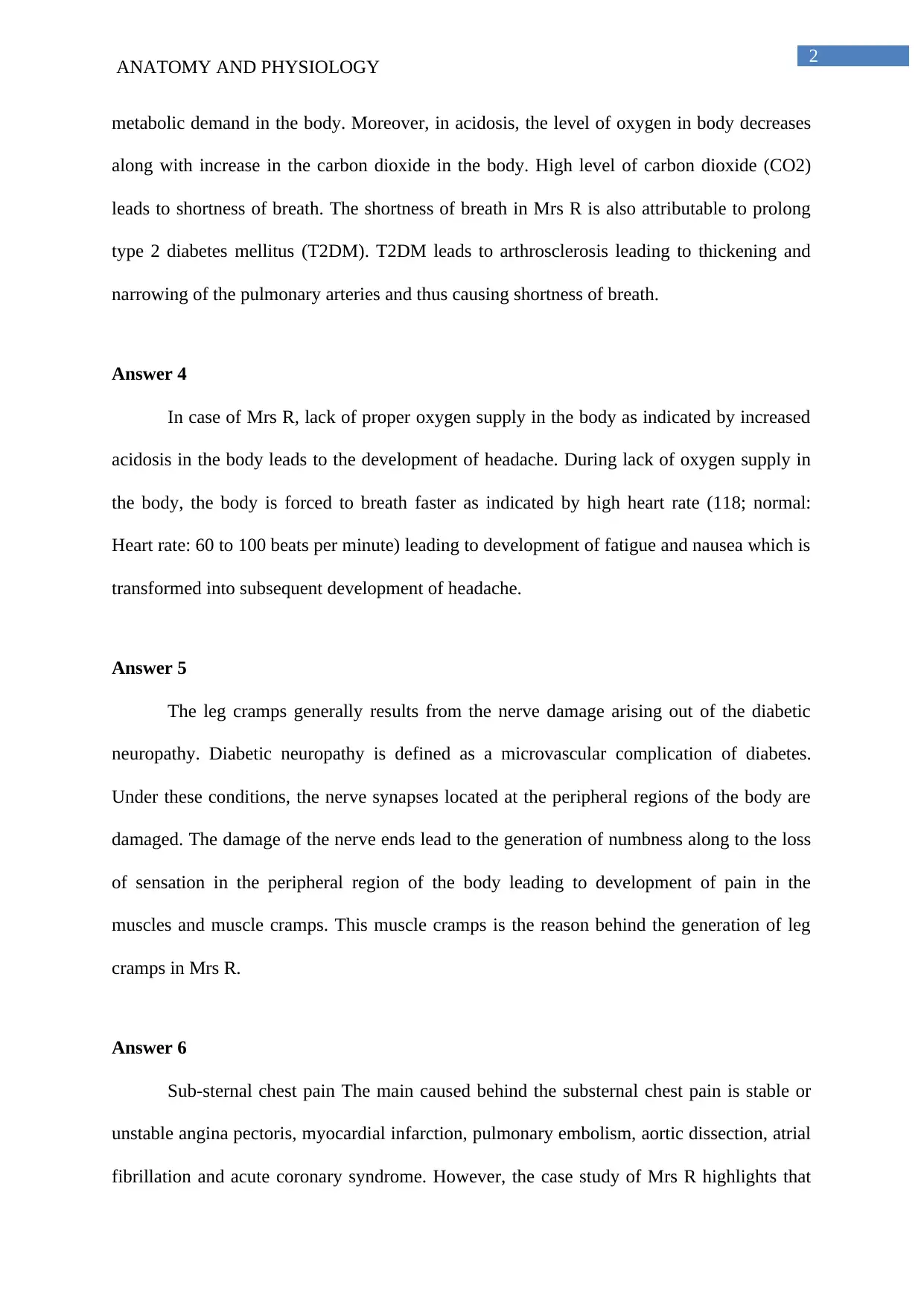
2
ANATOMY AND PHYSIOLOGY
metabolic demand in the body. Moreover, in acidosis, the level of oxygen in body decreases
along with increase in the carbon dioxide in the body. High level of carbon dioxide (CO2)
leads to shortness of breath. The shortness of breath in Mrs R is also attributable to prolong
type 2 diabetes mellitus (T2DM). T2DM leads to arthrosclerosis leading to thickening and
narrowing of the pulmonary arteries and thus causing shortness of breath.
Answer 4
In case of Mrs R, lack of proper oxygen supply in the body as indicated by increased
acidosis in the body leads to the development of headache. During lack of oxygen supply in
the body, the body is forced to breath faster as indicated by high heart rate (118; normal:
Heart rate: 60 to 100 beats per minute) leading to development of fatigue and nausea which is
transformed into subsequent development of headache.
Answer 5
The leg cramps generally results from the nerve damage arising out of the diabetic
neuropathy. Diabetic neuropathy is defined as a microvascular complication of diabetes.
Under these conditions, the nerve synapses located at the peripheral regions of the body are
damaged. The damage of the nerve ends lead to the generation of numbness along to the loss
of sensation in the peripheral region of the body leading to development of pain in the
muscles and muscle cramps. This muscle cramps is the reason behind the generation of leg
cramps in Mrs R.
Answer 6
Sub-sternal chest pain The main caused behind the substernal chest pain is stable or
unstable angina pectoris, myocardial infarction, pulmonary embolism, aortic dissection, atrial
fibrillation and acute coronary syndrome. However, the case study of Mrs R highlights that
ANATOMY AND PHYSIOLOGY
metabolic demand in the body. Moreover, in acidosis, the level of oxygen in body decreases
along with increase in the carbon dioxide in the body. High level of carbon dioxide (CO2)
leads to shortness of breath. The shortness of breath in Mrs R is also attributable to prolong
type 2 diabetes mellitus (T2DM). T2DM leads to arthrosclerosis leading to thickening and
narrowing of the pulmonary arteries and thus causing shortness of breath.
Answer 4
In case of Mrs R, lack of proper oxygen supply in the body as indicated by increased
acidosis in the body leads to the development of headache. During lack of oxygen supply in
the body, the body is forced to breath faster as indicated by high heart rate (118; normal:
Heart rate: 60 to 100 beats per minute) leading to development of fatigue and nausea which is
transformed into subsequent development of headache.
Answer 5
The leg cramps generally results from the nerve damage arising out of the diabetic
neuropathy. Diabetic neuropathy is defined as a microvascular complication of diabetes.
Under these conditions, the nerve synapses located at the peripheral regions of the body are
damaged. The damage of the nerve ends lead to the generation of numbness along to the loss
of sensation in the peripheral region of the body leading to development of pain in the
muscles and muscle cramps. This muscle cramps is the reason behind the generation of leg
cramps in Mrs R.
Answer 6
Sub-sternal chest pain The main caused behind the substernal chest pain is stable or
unstable angina pectoris, myocardial infarction, pulmonary embolism, aortic dissection, atrial
fibrillation and acute coronary syndrome. However, the case study of Mrs R highlights that
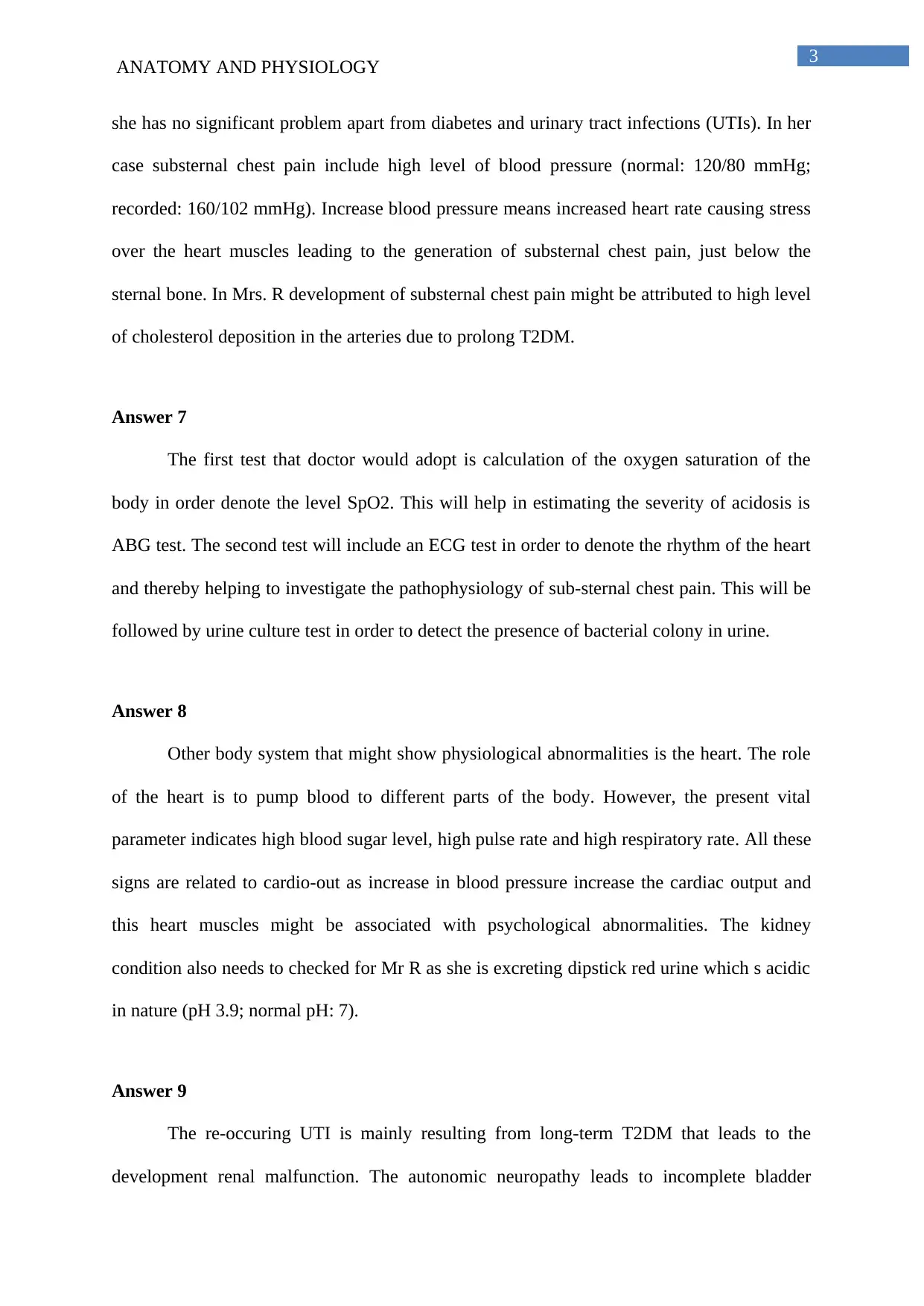
3
ANATOMY AND PHYSIOLOGY
she has no significant problem apart from diabetes and urinary tract infections (UTIs). In her
case substernal chest pain include high level of blood pressure (normal: 120/80 mmHg;
recorded: 160/102 mmHg). Increase blood pressure means increased heart rate causing stress
over the heart muscles leading to the generation of substernal chest pain, just below the
sternal bone. In Mrs. R development of substernal chest pain might be attributed to high level
of cholesterol deposition in the arteries due to prolong T2DM.
Answer 7
The first test that doctor would adopt is calculation of the oxygen saturation of the
body in order denote the level SpO2. This will help in estimating the severity of acidosis is
ABG test. The second test will include an ECG test in order to denote the rhythm of the heart
and thereby helping to investigate the pathophysiology of sub-sternal chest pain. This will be
followed by urine culture test in order to detect the presence of bacterial colony in urine.
Answer 8
Other body system that might show physiological abnormalities is the heart. The role
of the heart is to pump blood to different parts of the body. However, the present vital
parameter indicates high blood sugar level, high pulse rate and high respiratory rate. All these
signs are related to cardio-out as increase in blood pressure increase the cardiac output and
this heart muscles might be associated with psychological abnormalities. The kidney
condition also needs to checked for Mr R as she is excreting dipstick red urine which s acidic
in nature (pH 3.9; normal pH: 7).
Answer 9
The re-occuring UTI is mainly resulting from long-term T2DM that leads to the
development renal malfunction. The autonomic neuropathy leads to incomplete bladder
ANATOMY AND PHYSIOLOGY
she has no significant problem apart from diabetes and urinary tract infections (UTIs). In her
case substernal chest pain include high level of blood pressure (normal: 120/80 mmHg;
recorded: 160/102 mmHg). Increase blood pressure means increased heart rate causing stress
over the heart muscles leading to the generation of substernal chest pain, just below the
sternal bone. In Mrs. R development of substernal chest pain might be attributed to high level
of cholesterol deposition in the arteries due to prolong T2DM.
Answer 7
The first test that doctor would adopt is calculation of the oxygen saturation of the
body in order denote the level SpO2. This will help in estimating the severity of acidosis is
ABG test. The second test will include an ECG test in order to denote the rhythm of the heart
and thereby helping to investigate the pathophysiology of sub-sternal chest pain. This will be
followed by urine culture test in order to detect the presence of bacterial colony in urine.
Answer 8
Other body system that might show physiological abnormalities is the heart. The role
of the heart is to pump blood to different parts of the body. However, the present vital
parameter indicates high blood sugar level, high pulse rate and high respiratory rate. All these
signs are related to cardio-out as increase in blood pressure increase the cardiac output and
this heart muscles might be associated with psychological abnormalities. The kidney
condition also needs to checked for Mr R as she is excreting dipstick red urine which s acidic
in nature (pH 3.9; normal pH: 7).
Answer 9
The re-occuring UTI is mainly resulting from long-term T2DM that leads to the
development renal malfunction. The autonomic neuropathy leads to incomplete bladder
Secure Best Marks with AI Grader
Need help grading? Try our AI Grader for instant feedback on your assignments.
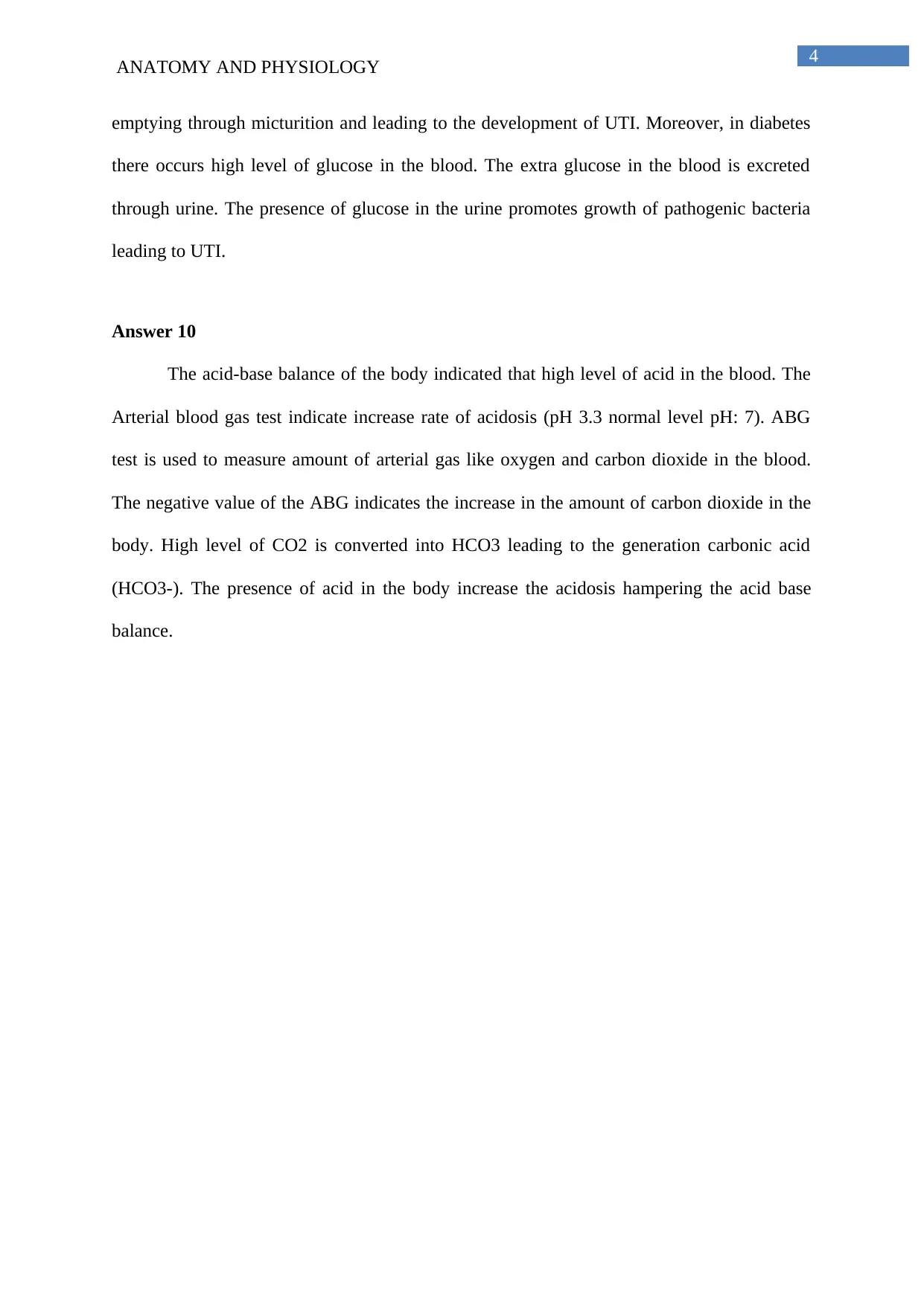
4
ANATOMY AND PHYSIOLOGY
emptying through micturition and leading to the development of UTI. Moreover, in diabetes
there occurs high level of glucose in the blood. The extra glucose in the blood is excreted
through urine. The presence of glucose in the urine promotes growth of pathogenic bacteria
leading to UTI.
Answer 10
The acid-base balance of the body indicated that high level of acid in the blood. The
Arterial blood gas test indicate increase rate of acidosis (pH 3.3 normal level pH: 7). ABG
test is used to measure amount of arterial gas like oxygen and carbon dioxide in the blood.
The negative value of the ABG indicates the increase in the amount of carbon dioxide in the
body. High level of CO2 is converted into HCO3 leading to the generation carbonic acid
(HCO3-). The presence of acid in the body increase the acidosis hampering the acid base
balance.
ANATOMY AND PHYSIOLOGY
emptying through micturition and leading to the development of UTI. Moreover, in diabetes
there occurs high level of glucose in the blood. The extra glucose in the blood is excreted
through urine. The presence of glucose in the urine promotes growth of pathogenic bacteria
leading to UTI.
Answer 10
The acid-base balance of the body indicated that high level of acid in the blood. The
Arterial blood gas test indicate increase rate of acidosis (pH 3.3 normal level pH: 7). ABG
test is used to measure amount of arterial gas like oxygen and carbon dioxide in the blood.
The negative value of the ABG indicates the increase in the amount of carbon dioxide in the
body. High level of CO2 is converted into HCO3 leading to the generation carbonic acid
(HCO3-). The presence of acid in the body increase the acidosis hampering the acid base
balance.
1 out of 5
Related Documents
Your All-in-One AI-Powered Toolkit for Academic Success.
+13062052269
info@desklib.com
Available 24*7 on WhatsApp / Email
![[object Object]](/_next/static/media/star-bottom.7253800d.svg)
Unlock your academic potential
© 2024 | Zucol Services PVT LTD | All rights reserved.





